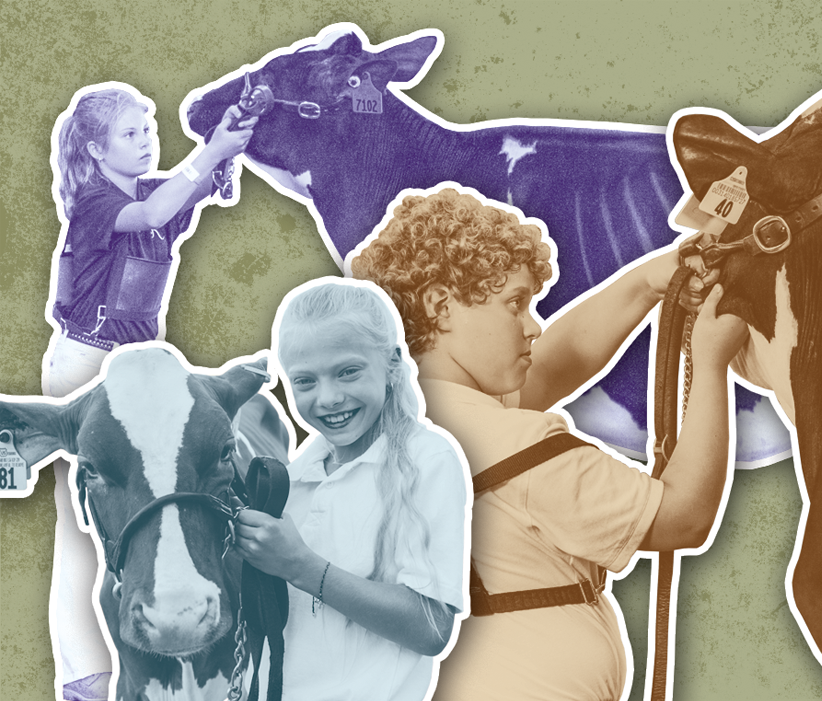Here’s hoping 2021 will bring back county and state fairs and youth dairy exhibitions. During these winter months, here is an activity to get dairy youth thinking about their projects.
Gather around the table or hold a virtual meeting, and take this knowledge test. A bag of treats and a piece of candy for correctly answered questions adds to the fun.
Find answers to these questions below.
Herdsmanship
Question 1
True or false: When making a straw and shavings bedding pack, you begin by placing shavings on the bare floor.

Do you know how to create a straw and shavings bedding pack properly? Courtesy photo.
Question 2
What is the number one priority for the size of your bedding pack?
- Make sure there is enough room for your tent and supplies.
- Make sure there is room for chairs and a table to play cards on.
- Leave enough space for your clipping chute.
- Be sure each animal has enough space so that they can comfortably lie down.
Question 3
Stall signs for the show should include which of the following pieces of information:
- Easy-to-read font
- Animal’s full name
- Be readable from 15 feet away
- Include the birthdate or class the animal shows in
- Sire and dam information
- Owner’s name
- All of the above
Question 4
True or false: After emptying the wheelbarrow, it is best to stop at the wash rack and rinse it out.
Question 5
Aisles should be swept:
- Once a day
- Twice a day
- Whenever there is debris (straw, shavings, feed) in the aisle
Halter Breaking
Question 6
When catching an animal for the first time with a halter, it is best to:
- Move quickly.
- Have loud music playing in the barn.
- Work quietly, slowly and patiently.

Correct halter use is key for a good showing. Do you know what to do? Courtesy photo.
Question 7
When tying an animal upfor the first time, you should:
- Keep her head down and have 2 to 3 feet of rope.
- Tie her with her head up with 1 foot of rope.
- Leave her tied up for several hours.
Question 8
At the beginning of training on the halter, you should:
- Let the heifer run around on the end of the rope.
- Keep your hand close to the halter and use a pull-and-release method, always keeping her head up.
- Walk her with her head down.
- Be consistent.
Question 9
When working your heifer on a show halter, it is best to do which of the following (select all answers that apply):
- Help the animal to walk with her head down.
- Walk with the head up at an efficient pace.
- Fit the halter halfway between the nose and eyes.
- Keep the chain snug.
- Place your finger through the ring on the side of the halter.
- Practice setting the heifer up correctly.
Showmanship
Question 10
Having a cellphone in your pocket in the show ring receives what discrimination?
- It’s OK to have a cellphone.
- Slight discrimination – you will lose a placing.
- Moderate fault – you will lose several placings.
- Serious discrimination – no matter how good of a showman you are, you will be (should be) placed at the bottom of the class.
Question 11
When leading into the ring, which of these practices is recommended?
- Walk forward, with left hand in halter and strap rolled neatly in left hand.
- Pull animal’s throat using right hand.
- Walk into the ring at an efficient pace, allowing the judge to compare animals in a timely manner.
- Walk in slowly and backward.
- Walk right along the rail or outside of the ring.
- Tap an animal ahead of you so they move out of the way.
- Once the entire class is in the ring, turn and walk backward.

Do you know how to lead into the ring? Courtesy photo.
Question 12
When setting the animal up, which of the following are best practices?
- Apply pressure from the halter and a hand on the shoulder to set the animal up.
- If necessary, use your feet to place the back feet correctly.
- Squarely line up the front feet.
- Use your foot to move the heifer’s front feet into position, if they are not squared.
- Once the is heifer set up, stand in front of her to give a professional presentation.
- Make the heifer appear straight on top by stretching her feet out a little and pull the skin behind her shoulder or poke her belly.
- Stand at the heifer’s shoulder to make her appear smaller than she is.
Question 13
Once your heifer is pulled into line, which of the following are best practices?
- If placed first or last in line, the outside leg on a heifer should be back to give her a longer appearance.
- If not first or last, pull the heifer into line and set her up with one rear leg back. It doesn’t matter if she is stretched out as long as one leg is back.
- When the judge walks from one end of the line to the other, switch the rear legs.
- When pulling into line, leave 3 to 4 feet of space between you and the heifer in front of you.
- When lining up, make sure the shoulder of the heifer is lined up with the animal in front of you.
- Once in line, it is OK to circle the animal if she gets forward in the line or doesn’t set up properly.
Question 14
When the judge works the class from the front of the line, you should:
- Turn all the way to the front and face the judge, allowing them to clearly see the front end of your heifer.
- When the judge walks down the line in front of the animals, quickly turn and move the rear feet of the heifer.
- When presenting your animal to the judge, make sure they can see the front of the heifer, even if you cover up the person next to you.
- When the judge walks to the right side of your heifer, quickly move to the left side of your heifer’s head.
Answers
- False. Start the pack with straw that is well-shaken. Pack down with a fork, add a layer of shavings and repeat until the final pack is at least 6 inches high.
- The number one priority is to provide enough room so all animals may lie down at the same time. There are no exceptions to this, even if you have to leave your table and chairs at home or skip the tent.
- All of the above
- True. Always rinse the wheelbarrow out after emptying.
- Sweep the aisles whenever there is debris in them.
- Work quietly, slowly and deliberately. You are building trust, so always go slowly.
- Tie the animal with its head up, giving her about 1 foot of rope. Leaving too much rope may cause serious injury. For the first few days, tie up the animal for no more than 20 minutes.
- Keep your hand close to the halter, use a pull-and-release method and always walk the heifer with her head up for more control. Be consistent in your training too. Never allow a heifer to run while on a halter.
- Keep the heifer’s head up and walk at an efficient pace. Don’t let her get ahead of you, or she may take off and you’ll be left behind.
- Fit the halter correctly to save last-minute scrambling at the show. Keep the chain snug so it doesn’t pop off when pulled. Never put your finger through the ring; there is no point to this, and it’s a good way to injure your finger.
- The more that you practice setting up at home, the better your heifer will respond on show day.
- There is no place for cellphones in a show ring. Showmanship judges are looking for this.
- Don’t walk into the ring backward. Do walk at an efficient pace. This allows the judge to compare every animal or exhibitor in the class. If you get behind the heifer in front of you, do not touch that animal. Make a clockwise circle and get back into position.
- Do not use your foot to place the back feet of your animal. Keep working with the animal to get her set up correctly.
- Do not stretch a heifer out and poke her belly or pull the skin behind her point of elbow. This practice is not necessary if you simply keep the heifer’s top up and set her up with legs underneath.
- Always stand to the front of the heifer, not to the side at her shoulder. Standing beside her makes her look smaller.
- Set up the heifer with legs underneath her, not stretched out. Too many people lose showmanship because they didn’t set their heifer up as well as they could in the line. You do not need to switch legs once you are in line. When in line, just leave your body width of space so that you have room to work. No more, no less.
- Once you are in line, stay there. This helps the judge compare the animals side by side. If you are circling your animal repeatedly, it is challenging to do this. Get your animal in line, make them stay there and do not pull out of line until the judge instructs you.
- It is not necessary to move rear feet as the judge walks from side to side. When the judge is in front of the line, just face them and stand still. Do not cover up the person beside you. Always present your animal from the right side.









